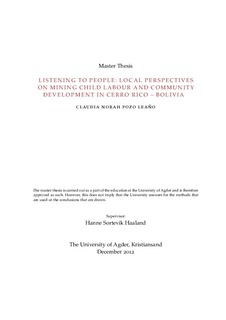| dc.description.abstract | This study explores community development from below in Cerro Rico mining
community taking child labour as a start point for analysis. The investigation
aims to generate knowledge about the potential of the community to generate a
socially inclusive, equitable, and sustainable process of development from within
the community. At the same time, it seeks to refine the understanding of child
labour in this context.
Development trends have paid more attention to the local cultures and indigenous
knowledge in recent decades. Alternative development conceives the social forces
as the main drivers for development where the community is the central agent
for development. From this perspective, the view of the local people on their own
realities becomes essential points for approaching community development processes.
Cultural characteristics and local perceptions are also considered to give
shape to complex local problems like child labour. Regarding this topic, debates
have questioned whether child labour should be banned or regulated. The divergent
positions towards these discussions have been considered to be pegged to the
understanding of childhood, and the role of children in the society. In addition to
this, the burden between harmless and harmful work has been deemed a quite
subjective culturally embedded estimation that complicates the arrival to a neat
definition of child labour.
The empirical investigation of this research is based on a case study of Cerro
Rico mining community in Potosí. I have adopted a people-centred approach, as
the local perceptions of the community have guided my analysis. This departs
from investigating the social attitudes and views on child labour and thereafter
it contrasts those with the social and economic context of the mining community.
The analysis includes numerous arguments on community development issues
that have been raised by the local people.
Considering the negative returns of the mining activity in terms of human development,
the empirical findings have shown that for a bottom-up development to
take place, synergies between the local people and key stakeholders are needed.
This entails self-awareness and reflexivity from the NGOs that are part of the collective
actions towards the eradication of mining child labour. Equally, my research
shows that there is need for a comprehensive approach towards the drivers of child
labour, that includes the identification of the structural factors which causes this
type of work, yet with sensitivity towards the local context. Finally, development
policies rendered by the government with goal of regulating the mining exploitation
in Cerro Rico have been found essential, both for tackling child labour, and
for improving the social and economic conditions of the community. | no_NO |
